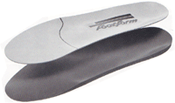
Chances are you've heard of the word orthotic. If you're wondering exactly what a orthotic is, the dictionary isn't much help. Though an orthotic can be a brace or artificial limb, the word usually refers to an insert or insole a person wears in their shoe for extra support for their feet.
The orthotic is most often made of foam rubber, cork, plastic, leather or wool, even metal or some combination of these items. Orthotics/insoles cost as little as $30.00 to has high as $800.00. You can purchase a pair over the counter, at a shoe or athletic store, mail-order, or from a medical professional such as a physical therapist, chiropractor, podiatrist or pedorthist.
The over the counter pre-made types are self-explanatory. Custom orthotics are a different story and it is confusing to sort through the variety. There are several types of custom orthotics: pre-made then custom fitted, pre-made "blanks" that are heated and molded around the bottom of your foot, glued together components, or custom molded/custom made orthotics.
My specialty is the custom molded/custom made orthotic. There are four important parts to orthotics success.
- The molding method of the orthotic (how the orthotic shape is determined).
- The materials the orthotic is made of and the properties of those materials: shock absorption, flexibility, durability, etc.
- Shoe fit and compatibility of the orthotic in the shoe.
- The client's efforts to change gait and stance habits for the better.








